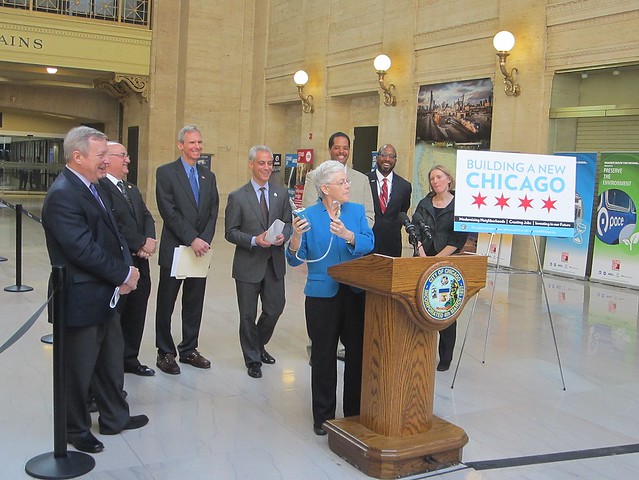
This morning, local politicians heralded $7 million in new funding for a terminal planning study and service development plan that will help increase capacity at Chicago’s 90-year-old Union Station and on the rail lines that lead to it. This comes in addition to the $12 million that Amtrak pledged back in January for rehabbing the historic terminal. The city of Chicago eventually hopes to work with the United States Department of Transportation, the state of Illinois, Metra and Amtrak to undertake a complete overhaul of the station, which would take several years and cost an estimated $500 million.
Union Station is the nation’s third-busiest station, serving over 300 trains per weekday, with about 115,000 Metra commuters and 10,000 Amtrak customers using the terminal each weekday. It’s the busiest railroad station in the Chicago region, which see more than 700 commuter and passenger rail trains and 500 freight trains on a daily basis.
The study will help coordinate routes and operations for rail service approaching Chicago from the east, south, and west, officials said. It will also look at strategies for improving air quality, pedestrian flow, and retail space inside Union Station. The funding includes $3 million from the Federal Railroad Administration, $2 million from the state of Illinois, $1 million from Metra, and $1 million in tax increment financing from the city.
“Not only do we want to make sure the passengers get here on time, we want Union Station to be a first-rate station,” said U.S. Senator Dick Durbin at a press conference in the station’s Great Hall. “For visitors coming from long-distance Amtrak trains, Union Station is their first glimpse of Chicago. This magnificent hall is a testimony to that glory day in American history when trains were really considered to be the center point for economic activity. That day is coming again.”
Durbin noted that improving air quality at the station is key. In 2010, the Chicago Tribune found that many enclosed stations in Chicago had high levels of toxic train exhaust, which has been linked to a number of serious health problems. The senator said that various government agencies have worked together to clear the air since then, but more improvement is still needed.
Amtrak’s Derrick James noted that reducing delays as trains enter and leave the station will go a long way towards improving customer satisfaction. “On Amtrak runs originating in Chicago, the delays are often on that last mile to and from Union Station.” He said the grant will go a long way towards fixing those problems, so that investments in higher-speed service being made in downstate Illinois, Michigan, and Indiana are not negated once the trains get to Chicago.
Mayor Rahm Emanuel noted that the station is the nexus of Amtrak and Metra, the CTA Blue Line is nearby, and the city will be building a new bus terminal across the street from the station as part of the upcoming Loop Link bus rapid system. “Union Station, when you bring all those transportation networks together, is fighting below its weight class and its potential.” He recently sent a team to check out recent improvements at Denver’s Union Station to get ideas for Chicago’s terminal. Emanuel added that that, if he’s able to secure the $500 million for the station overhaul, he believes the investment would lead to $7 billion in economic growth in the station area.
U.S. Environmental Protection Agency chief Gina McCarthy said that, as part of the study, her agency will be monitoring air quality at the station for a month, starting in mid-June. She displayed an odd-looking gadget consisting of a small box with tubing attached. “If you’re taking the train over those four weeks, you may see [EPA scientists] wandering on the outside platform with this clipped on.”
She apologized for being a few minutes late for the presser. “That is because apparently we haven’t spread the word that you need to get out of your cars and into trains. That is why we’re here today, because trains are great. If you haven’t tried them, you ought to.”




